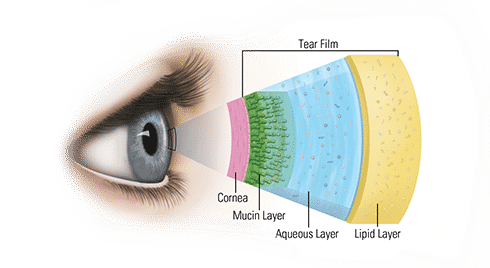As we age, the natural processes that our bodies use to keep our eyes moist and comfortable can falter. This can result in patients experiencing chronic eye irritation, eye redness, and even decreased vision.
What are the ways that our bodies naturally keep our eyes comfortable?
Our eyes produce a complex liquid that bathes and heals our eye surface. This liquid is our tears!
Tears are complex, and have multiple layers. There is a mucous layer that helps the tears to adhere to our eyes’ surface. There is a liquid layer that bathes the eye. Finally, there is a fat or lipid layer that prevents the liquid from evaporating too quickly.

These tear components are made in the eyelid and lacrimal glands. Age and certain medical conditions can adversely affect the process, and can affect our ability to make the complex, 3-layered tear components. This can lead to Dry Eye.
As we age, inflammation can occur in our bodies generally and in the lacrimal or tear gland specifically. This is particularly common in women.
Inflammation can negatively impact the lacrimal gland’s ability to create the liquid portion of our tears.
In addition, both age and facial rosacea can cause redness to occur in the face and in the eyelid itself.This can affect the eyelid glands’ (meibomian glands’) ability to create the lipid or oil layer of the tears. This results in tears evaporating too quickly.
Treatment Options
Traditional treatments for dry eye involve artificially-generated solutions placed on the eye multiple times during the day. These are designed to replace the lost liquid tears that should normally be generated by the lacrimal gland.
This can work to a certain degree, but doesn’t replicate the true make up of our natural tears.
We now have the ability to provide our patients with a more natural substitute for the tears that they’ve lost. It’s called Platelet Rich Plasma (PRP) tears.
PRP tears are derived from a person’s own body. This is accomplished by taking platelets and plasma from the patient’s blood and mixing them with saline to create personalized, nutrient rich, growth factor rich natural tears.
This protocol has been shown to help people with Dry Eyes, Recurrent Corneal Erosions, certain Corneal Dystrophies (Map, Dot, Fingerprint), and non-healing corneal ulcers.
It’s a step into the world of Regenerative Medicine.
A second option that we now offer involves using BroadBand Light (BBL) to help patients who have Rosacea that causes dry eyes. People with facial redness or redness on the eyelids often have problems generating the natural oil component of the natural tear solution. This oil is important because it prevents the liquid part of the tears from evaporating too quickly.
BBL treatment involves numbing the eye’s surface with eye drops, then placing special gold eye shields onto the eyes to protect them.A cooling gel is then placed on the eyelids, close to the eyelashes in order to treat the underlying meibomian gland. The BBL crystal with a small spot size is used to directly treat the skin overlying the meibomian glands of the lower lids.
This light treatment closes the abnormal vessels that cause meibomian gland dysfunction and decreases the bacterial load on the eyelash margin. The treated eyelid is then massaged to release the newly liberated oils into the tear film.
This process results in a restoration of natural oil production from the eyelids, allowing the tears to resume the process of properly bathing and soothing the eyes.
You can see the results of this procedure in the photos below. The eyelid margin redness is an indication of meibomianitis in this patient, who had only one eyelid treated.
You can also see the difference in the staining of the cornea between the eye that had the BBL treatment and the one that did not.
These treatments are not currently covered by insurance. Please contact our office for more information.
These two new treatment approaches have created a marked improvement in patients’ suffering from Dry Eye. We are happy to be of service to patients suffering from this condition.






